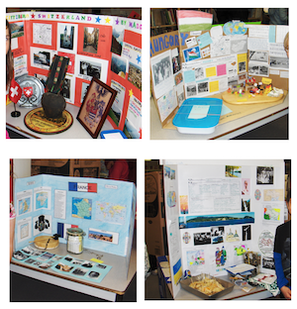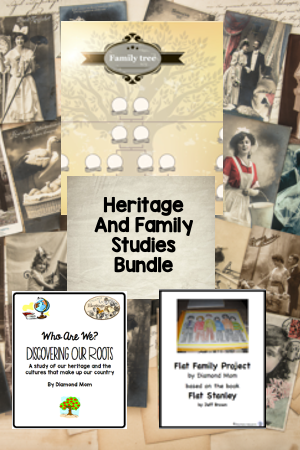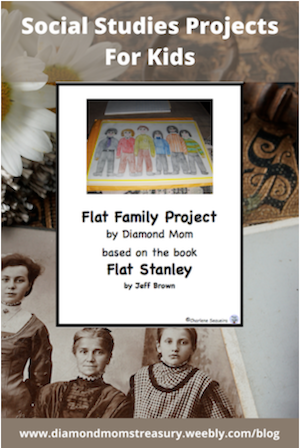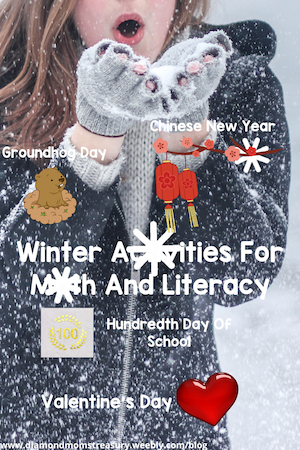How to help children learn about their family heritageTeaching about family and cultural diversity can be fun, but also tricky. It is a time when some people may find it difficult to share or investigate their roots. I learned this as a fairly new teacher. I hope to be able to help change this. I had a young girl who was afraid to let people know about her background because she had been teased at a former school. She chose to use her mom's last name instead of her dad's last name because she didn't want people to know her nationality. This really disturbed me. How could people make such a young person feel like this? It was so bad, that when her half sister came to visit, she didn't want to share about her visit because they would hear her name and tease her. (at our school this would not have been the case, but she didn't realize that) I decided that I needed to do something about this. I wanted my students to be able to celebrate their heritage and be proud of it, not ashamed. I decided to create a unit where they could research the places where their families came from and share different traditions, cultural activities, food, and even special articles or memorabilia. At the time that this unit was forming in my mind, my son was teaching in South Korea, and I had an exchange student from the place where he was teaching. This allowed me to work with the young student at the same time. (He had very limited English, so I was able to support him with his research and presentation.) I called the unit Who Are We? Discovering Our Roots. This unit was far more successful than I ever imagined. Every child created an incredible display of who they were and shared enthusiastically with others when we did a school wide presentation and a presentation to parents. We had music, food, special items that were from their culture and fabulous backdrop displays, The best part was, that everyone was excited to celebrate who they were, even my little girl who was so afraid earlier. As a matter of fact, she shared both her father's and her mother's roots. I decided to recreate this unit a few times throughout my teaching career, and each time I was thrilled to see how enthusiastically the kids embraced who they were and shared their traditions with others. A few years ago, I learned about people sending cutouts of themselves around the world on adventures. I discovered that this was something that came from an idea based on the Flat Stanley books written by Jeff Brown. I thought this would be fun to do, but I decided to put more of an educational twist on it. I decided that we would send out flat families around the world to different relatives that lived far away from us. That is how the Flat Family Project was born. I did this project a couple of times before I retired and it was so much fun for the kids. Each child sent away a journal and a hand drawn picture of their family along with a letter and a return envelope. Throughout the following weeks packages arrived at the school filled with journal entries and photographs of the flat family adventures. Many also included special items from their family members that would be cherished keepsakes for years to come. I did have a couple of students that were unable to connect with a family member elsewhere, but they were still able to participate. I contacted some of my cousins and they said they would get their children to help out. It was so good to know that everyone would be able to take an adventure and receive a parcel back. (I did check with the students' families to see if they were okay with this.) One of the families even sent back a book for our class with an inscription and drawing of their flat family. If you would like to check out either of these projects, you can find them here. I know that I would be doing them again if I was still in the classroom. Related Posts
0 Comments
Fun Ways To Teach Children About Mapping And CommunitiesLearning about the world around you is an exciting concept and a time of wonderment for children. They enjoy learning about how maps work, as well as what makes up the community around them, the country they live in, and other countries around the world. There are many ways to teach these skills to kids. I personally like to do it through hands on activities and research projects. In most curriculums teaching about community is a starting place for learning about the world around them. This involves learning about the different types of communities - urban, suburban, rural, and the features that identify them. This can be done by using books, videos, and field trips. One of my favorite things to do with my class was take neighborhood walks to check out the area around the school. Kids were excited to walk through their neighborhood and point out their houses and favorite places to others. They would take note of the different parks, forested areas, types of buildings, businesses, and other important landmarks. When we returned to the classroom we would discuss these different things and why they were important. We would also talk about how their neighborhood might be different from other communities and their neighborhoods. Many younger groups of children go on field trips to the fire station, police station. farms. grocery stores, etc. as part of their education about communities. They may also have visiting members of the community as part of their community helpers unit. Of course, depending on the type of community, these locations and visitors will vary. We can build on all of this information when learning about communities in more detail. It opens up discussion as to where different services and industries are located in the community and why these areas may have been chosen. Learning how to read maps and recognize symbols and locations on them is an important skill when studying about communities and geography. I have created some resources that help with this. It is important that we not assume that kids already know much about how maps work. Some may, but others will need to be walked through the different features and how to use them. This Map Skills booklet breaks it down into simple ideas. Once they understand how maps work, it is good to add some practical applications. Learning to use grids effectively can be practiced using different grid games and activities. Check out this mapping resource that uses grids.There is a digital version available also. If you really want to see if your students understand about communities, try out this project. It is a great way to incorporate all that you may have been studying. It begins will talking about the various types of communities, and then choosing a type of community to plan, design, and build. The design plan is directed by the children through discussions as to where to put things, what is needed, why they are placed in certain locations, and what the street plans will be. Scale is discussed and then the building of the 3D community begins. Check out these photos for some examples of one of the communities my classes built. If you are interested in a resource that will combine all of these elements, check out my bundle here. I hope your students enjoy learning about mapping and designing a community as much as mine did. I would love to see pictures if you choose to make a 3D community. Related PostsWinter Celebrations Are ApproachingIt's time again to celebrate as we approach February and all the various celebrations and special days that are happening soon. We have Chinese New Year, Hundredth Day of School, Groundhog Day, Valentines Day and in some cases other special days as well. What better time to add a little fun and theme into daily lessons than now. First up is Chinese New Year. This celebration lasts for two weeks, so it can actually be a focus for more than one day. Kids love to hear the story of the animals in the Great Race and learn about the zodiac animals and the years they are linked to. This year is the year of the Tiger. Why not use a tiger theme when doing activities to do with Chinese New Year. I have a bundle of sight words that features each of the different animals of the zodiac. They are fun to use and they can be helpful as children learn to recognize high frequency words. You can check them out here. I also have a couple of other resources that work well for math and literacy. Chinese New Year Activities includes some math and literacy activities. Winter Fun Math Activities features special activities for Chinese New Year as well as Valentines Day and Hundredth Day of School. Groundhog Day comes right after Chinese New Year this year. It is fun to find out if the groundhog will predict more winter or an early spring. With all the snowstorms and floods we have had this winter, so far, where I live, an early spring would be welcome. Here is a Groundhog Day Activity booklet of math and literacy ideas that I created that might be fun to use for this day. If you are interested in Groundhog themed sight word cards, I have a set of them available also. For 2022, a special day is coming to celebrate twos. It is the second day of the second month of the twenty-second year of this century. Wow! What a great opportunity to work with numbers and enjoy this event. Maybe Groundhog Day could be combined with Twos Day. Here is a resource I created for this day. It can also be used at other times of the year. Of course, when you mention February, people immediately think of Valentines Day. There are so many different activities and crafts available to celebrate this day of friendship and love. Here are some that might be of interest to you. Valentines Sight words and bingo Valentines Day Math And Language Games Numbers And Number Words Match Themed Place Value Practice Do you celebrate the hundredth day of school? I know that this is a popular celebration at many elementary schools where I live. It is a day to do everything "Hundreds". At schools that I worked at, we would have tables set out in the hallways to display collections of a hundred. Primary classes would sometimes get together to do activities as well. Here is an activity resource that might be of interest for One Hundred Days at School. Well, there you have it. A bunch of ideas and resources to make your special days fun for your students. I hope you enjoy these days of celebration. Related PostsHopes and dreams changed by the unexpectedTwo years ago we headed into the New Year with hopes and dreams for an exciting year ahead. No one was ready for the change that happened in March of 2020. All of a sudden, we were thrown into unknown territory and a completely different way of teaching. There was lots of uncertainty and we were overwhelmed with learning how to navigate this new world. Teachers, students, colleagues, parents, and the community at large were worried, scrambling to figure out how to work virtually, scared of the unknown. and wondering how to stay safe. Fast forward to December 2021. We thought we had things more under control and we were starting to reconnect with family and friends and beginning to return to a more familiar way of teaching and living. Plans were being made for holiday celebrations. Suddenly, this all changed as a new variant arrived. All the things we had been doing that were working, were no longer enough. Getting through the next waveThis new variant is reacting differently and we need to make adjustments again to get through this wave. How are we going to navigate through this next wave and still stay safe? I am sure this is a question on everyone's mind. Some places are going to online learning again while other places are still going to do in person instruction. All the protocols from the first wave are back in place, but are they enough? From what we are experiencing, they don't seem to be enough. We need to be even more vigilant than before. Hang in there. You've got this.I get that it is important for kids to have interaction with others, but I also wonder what kind of balance is needed between personal interaction for mental health and distancing for physical health. Nobody seems to know what will work right now. This crazy variant is finding us no matter where we are or how careful we are trying to be. This is one of those times when we have to do whatever we can to protect ourselves and those around us. If you are teaching in person, take care of yourself and try to focus on the kids and how you are there for them. I pray that the protocols in place will protect you and that your students will realize how much it means to be there for them. If you are teaching virtually, hang in there. I know that this is not why you became a teacher, and that it is difficult for you to be away from your students instead of interacting with them in the classroom. I pray that this will not be for too long and that you will once again be able to get back to teaching in a way that is satisfying and fulfilling. I have such admiration for you and all the teachers that are using every creative way they can think of to weather this next wave. Hang in there. You are appreciated and you are making a positive impact on kids. If you are looking for some ideas for how to incorporate projects and real life learning into your instruction during this time, check out some of my ideas in these posts.
Teaching And Learning Online And In Person Using Projects For Student Learning Learning At Home And Keeping Kids Engaged How The Way We Feel Affects How We Look At The WorldHappy New Year! It is hard to believe another year has passed. Who would have thought we would still be in the midst of a pandemic almost two years later. This year, it is important to be able to move on and look forward even though we are still dealing with restrictions and concerns over the virus that continues to impact our lives. We often focus on all the things that are going wrong and these things can make it difficult to see things that are going right in the world. I would like to challenge both you and me to try to find the good out there and make that a focus for 2022. Imagine how we could change the world if we were able to find the good in people instead of criticizing them. Think of all the positive energy we could add to a situation if we started to focus on what is right in the world. A teacher friend of mine sent out an email the other day that was a great reminder of this. She uses colours for moods and puts them in her planner each day to indicate what kind of day it was. She noticed that when she looked back at the year, she had many days that had positive moments that she might have forgotten about if she had not made a note of them. I have also seen different posts about gratitude jars. If we put one thought of gratitude on paper each day, or even each week, and put it in the jar, at the end of the year, we will be amazed at how much we have to be grateful for. Since it is the new year, this might be a good time to try that. In the fall, I wrote about gratitude and created a gratitude journal for the four seasons. You can find out more about it here. This is a great place to record thoughts and reminders of things to be grateful for. Kids would benefit from using this type of journal. It is important to learn how to appreciate things and focus on what we have instead of always thinking about what we want. I have created a personal feelings template that can be made into a personal feelings journal for the year. It is available on my followers free resources page for subscribers. I have added it to my Teachers Pay Teachers store for those who wish to purchase a copy. Our attitude affects how we feel. If we are hopeful and positive, we will make it through challenging time. I hope that you will have a year full of good memories. Hang in there. We've got this! Related Posts |
About Me Charlene Sequeira
I am a wife, mother of 4, grandmother of 9, and a retired primary and music teacher. I love working with kids and continue to volunteer at school and teach ukulele. Categories
All
|





















































 RSS Feed
RSS Feed